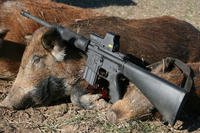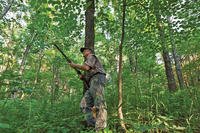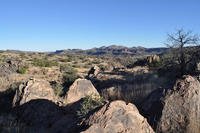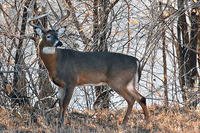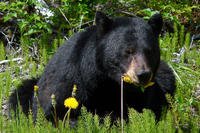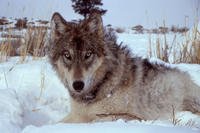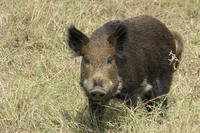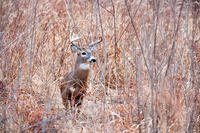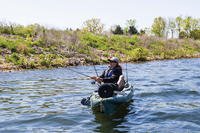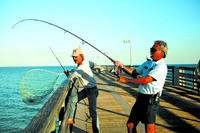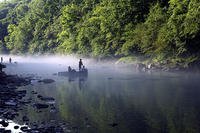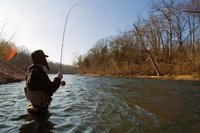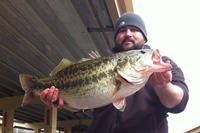Here’s what to do when deer refuse to show during daylight hunting hours.
by Bob McNally
After four years of hard hunting, I was pretty smug about how well I knew my 250-acre deer lease. My sons and I learned the locations of the best deer trails, where bucks scraped, where they fed on white oak acorns, where food plots were best planted, what stands were choice in certain wind conditions, how to approach the hot places, and where deer bedded and where they bred.
We'd put in our time, scouting and hunting, from August to January, and we had the heavily timbered lease down pat. Or at least so we thought, because over the years we collected plenty of whitetails, including some good bucks.
Then one late morning while shifting a ladder stand to a new ridge-side location above a tangled creek draw, I discovered a faint side-hill trail. It paralleled a more heavily used trail we regularly hunted from a ridge-top stand (where we'd busted several good bucks). But I'd never noticed the faint "new" trail until now. After setting the ladder stand, I inspected the faint trail a bit closer and found the biggest buck rubs I'd ever seen on the property. Four trees within 20 yards along the faint trail were rubbed so hard that all the bark had been whittled away right down to the white meat of the timber. The rubs were fresh, with shavings on the ground, and the rub trees, which were as big around as my upper thigh, had obviously been used for years. The rubs were made by a mature buck (or bucks), and oversize fresh tracks in the trail indicated that the deer was large and heavy.
To say I was excited is an understatement. The best buck we'd taken from the property was a 200-pound, 135-incher. But the rub and track sign looked as if it had been made by an even larger buck. My two sons and I immediately began targeting the area where I found the rubs. We placed stands at strategic places around the "faint trail," and we were careful to hunt them only during ideal wind and weather conditions. Knowing we were after a seasoned old buck, we were careful about accessing the area, avoiding human contamination of stands and trails.
But after two months of hard hunting for that better-than-average buck, we were still drawing blanks. We saw plenty of deer and a number of bucks, including several nice 8s and a decent 10-pointer. But we never saw the giant, and we never observed any of the other bucks rubbing the oversize trees I'd located.
That season drew to a close. Winter, spring and summer passed. Opening weekend of bow season that following year found my oldest son in a tree stand not far from the "faint trail" and the giant rub trees. He wasn't hunting the trail, but he was within sight of the spot. Our enthusiasm for the place had waned, as we rationalized that something must have happened to the big buck, even perhaps that he had been killed by a poacher. If another hunter had tagged him, we reasoned, we certainly would have heard about the buck — a deer of that size is hard to keep secret.
On the second afternoon of the opening weekend, my oldest son, Eric, watched does with fawns and young bucks parade past his stand. He was holding out for a good buck when movement caught his eye from the "faint trail" some 100 yards away. He saw the white glint of a good rack, got his binocular on the buck and carefully inspected a "shooter" 8-point as he ambled down the faint trail. Eric softly called on his grunt tube, then worked a doe bleat can a time or two. The buck stopped, looked and listened to Eric, but continued along the trail and into the thick creek draw.
Eric's adrenaline was pumping. He was on full alert, and that's when he got a look at the buck that had made the monster rubs on the "faint trail." He was a perfect 10, following the 8-pointer by about 10 minutes. He stopped and rubbed a couple of trees on the trail for a few moments, and Eric nervously watched him rip bark from the tree trunks. He figured the buck at well over 200 pounds, with extra-heavy beams and a high, wide rack that would go somewhere around 150 inches. Eric's grunt and bleat calls were ignored, and the buck disappeared in the creek drain like the 8-pointer before him.
I'd like to say we worked hard and collected that buck, but we didn't. Not that season, and not the next. To my knowledge, no one ever saw him again. No neighbors, no other hunters, no one. He just disappeared into another legend of an unkillable "noctural buck," the kind of whitetail serious hunters get all misty-eyed describing and thinking about. Such animals are the nemesis of deer hunters everywhere. Yet they're creatures greatly admired for their survival senses and their cunning abilities to avoid man and other predators almost like some alien life form observing humans from another dimension of time and space.
Creatures Of The Night
But are some bucks really that smart to completely alter their lives and only travel at night? Are they so old and educated in the ways of hunters that they can stay completely hidden from human eyes? Can such bucks regularly die of old age because no hunter is good enough to put them in his scope?
"You bet," says Ernie Calandrelli, noted New York hunter and pro-staffer for Quaker Boy Game Calls. "But nocturnal bucks only get that way from intense hunting pressure — usually the case on public land. It also happens in places where the hunting season is long, and pressure from hunters is unrelenting for many weeks at a time.
"I'm convinced a buck that lives to be 3½ years old is a smart, smart animal, especially on public property," Ernie continues. "He has to be to survive. If that deer lives to be 5½ or 6½ years old, he has learned so much about his core home terrain, and about how hunters do things in the woods, that he almost is unkillable because he has become like a nighttime ghost. That's hard to believe for some people, especially today with our advanced hunting techniques and great optics and other products that allow us to be better and more effective deer hunters than we ever thought possible.
"But I truly believe that some giant, old nocturnal bucks just can't be collected. Once in a great while you'll hear or read about someone — often a youngster or beginning hunter — tagging a gray-muzzle, old buck in a public place where no one thought such an animal could exist," Calandrelli says. "That's a fluke, but it sometimes occurs for a neophyte sportsman in a place no one would ever hunt — and that's where a great, old, smart nighttime buck figures to live during the onslaught of hunters in season."
Ernie says that sometimes small mini-drives in confined areas of buck cover can produce mature bucks that refuse to show themselves in the day. He has also taken a few heavy bucks he believed were nocturnal on the very edges of bedding areas in the very first or last gray light of day.
Pressure Them Out
Hunting smarter is the key to killing monster whitetails that quickly become nocturnal with the slightest bit of human pressure, says noted callmaker and hunting video producer Mark Drury. Mark's famous video of him arrowing a huge wild buck — a near-200-inch Pope-and-Young monster — was shot in an Illinois river bottom months after the spot was found and a stand hung. Mark and his brother, Terry, waited until conditions were ideal before they hunted the stand. They never entered the property, to keep human scent and activity away from the buck they knew lived in the hotspot they'd discovered. Their purpose was to keep deer calm, unwary, and still moving about during daylight hours until the ideal hunting time arrived.
The Drurys knew from lifelong deer-hunting experience that any mature buck that caught their scent would vacate the area completely, or become fully nocturnal without the hunters even knowing about it.
Hanging Treestand - To avoid alarming a nocturnal buck, hang your stand well in advance of the season and stay out of it until wind and weather conditions are exactly right.
"We wait until conditions are perfect, then make our move to a site we've scouted and from years of experience know will be the best place to intercept a giant buck," Mark says. "We don't go in the area, and don't want anyone else in the stand site location, until the ideal time is here, which is during the peak of the rut. Then, only during a calm, cold morning, with the wind perfect, do we hunt the spot.
"If conditions are poor, or it's warm or windy, we pack up and try another location, sometimes moving completely out of state," Drury says. "When conditions improve, we move immediately back to the original choice stand. Rarely will we hunt a stand more than a couple times, or we risk contaminating an area and forcing the biggest bucks to go nocturnal. Sometimes conditions never get perfect, and we don't hunt a spot an entire season, but we'll hit it the next year."
The Drurys' tactics are unquestionably successful, as evidenced by their many exciting videos of huge bucks collected throughout the country. In the real world of deer hunting, however, not all sportsmen have the luxury of waiting around for perfect conditions before hunting a red-hot spot. Indeed, it's tough not to climb right up a tree over a bunch of scrapes, or beside a trail full of rubs, the moment you discover the place. But that's often foolhardy if everything isn't perfect, because the more you hunt a place or an area, the more deer become aware of your presence and start moving about only after the sun sets.
The Big Ones Are Out There
It's easy for some hunters to believe their well-honed woodsman skills are superior to those of any deer. It's also common for sportsmen to believe that on public hunting grounds, there is so much pressure that it's impossible for bucks to grow old enough to sport bigger-than-average racks. Such beliefs lead people to think large bucks are simply unavailable on public or heavily hunted land. While there might be some truth to these concepts, every year some tremendous shed antlers are found on public and hard-hunted land throughout much of America. I've found huge shed antlers on public land and on private deer clubs where there are many members. Sheds tell an objective story about the deer living on a piece of land — and often show evidence of bucks larger than what many hunters believe are available.
But how common are such nocturnal bucks?
I think there are more such deer prowling America's whitetail habitat today than ever before, and I believe it's mainly due to modern management activities. Today, huge tracts of prime hunting land are under "Quality Deer Management" (QDM) rules. Such management strives to improve buck rack size through various means, such as having minimum-size racks for harvest. Such QDM regulations also are in effect on public land, and in some deer regions whole counties are under the rule. This produces bigger-than-average bucks for hunters, which is a great step forward in whitetail management.
But a side effect of QDM, I believe, is that there are now more noctural bucks in America than ever before. This is because on some QDM property it takes at least 3½ years to produce a minimum-size buck for harvest. No doubt QDM rules increase the number of such older, wider-rack bucks, and some are collected by fortunate hunters. But it also increases the number of deer that reach 5½ or 6½ years of age and older. An older mature buck in this category is a wholly different animal than one half that age. These are bucks with Ph.D.s in human hunting habits. They are the ultimate survivors, top of the heap in the predator-prey game, and many are like vampires — only moving when the sun sets.
Are such bucks untouchable?
Consider the observations of Mike Mooney, a Jacksonville, Fla., hunter with over 40 years of whitetail experience, several record-book bucks to his credit and wide-ranging travel in the whitetail game.
"Probably the easiest way for hunters to convince themselves there are noctural bucks on their land is to place remote cameras at key spots around the property," Mooney says.
"I've done that on dozens of sites, in many states, for a number of years now. I don't think I've ever put up cameras for a month or so without getting some great pictures of some huge bucks — at least relative to the area. That's enough to perk up any hunter — seeing pictures of great bucks near his stand site.
"While I've later seen many of the bucks I've gotten photographs of from my tree stands, I've never seen a great majority of the very largest bucks, because they only walk after the sun sets," Mooney adds.
Mike remembers a red-hot 100 acres he hunted in Iowa some years ago where his trail cameras were regularly getting photos of some huge impressive bucks, several in the 150-inch range. But in two weeks of hard hunting he never saw one of the bigger deer he had on film.
"It was really frustrating," he recalls. "It was private property, mostly farmland and grown-up hedge rows — pretty easy land to hunt, or so I thought. I had three different big bucks on film, and just knew I'd bust one of them during a hunt. Still, I never saw any of them, and it was on land that was completely isolated from other hunters — very private, so no one was spooking those deer unnecessarily.
"I eventually took a 135-inch buck, smaller than the ones I had photographed, and a buck I had no idea was even on the property," Mooney continues. "I think the big-racked bucks went nocturnal the moment they learned there was an increase in human activity in their core range."
How To Tag Them
So what's a hunter to do about the "untouchable" nocturnal bucks? Just accept the fact that they'll never be seen, and go on about the business of hunting?
"All whitetail hunters are optimists, or we wouldn't be wasting our time, effort and money trying to tag ghosts," says Dan Moultrie of Moultrie Feeders and trail cameras.
"Trail cameras establish that there are big bucks on a property, but hunters themselves make such animals nocturnal.
"Tough-to-get deer become that way by being around humans trying to shoot them," Moultrie continues. "So to harvest a mature nocturnal buck, you've got to have special, very refined tactics. First, I'd have my stands hung months ahead of the hunting season, and I'd leave them in place from one season to the next. Next, I'd hunt my very best spots only on opening weekend, during the five peak days of the rut, and the last weekend of the season (especially if it's bitter cold). Spend any more time in the area and your chances of that deer making a mistake and showing himself during the day are almost nil.
"I'd also never hunt unless conditions were absolutely perfect," Moultrie advises. "Cool, dry weather, good wind, no full moon. Then I'd hunt from as long range as possible, and sit all day. If you can overlook a mature buck hotspot from 200 or 300 yards, that's what you should do. The closer you are hunting a mature buck, the more likely you'll turn him into an after-hours vampire. This is what turns a tough-to-get old buck into an unkillable whitetail myth. And I'm sorry to say there are plenty of them around these days — far more than we'll likely ever know about."
